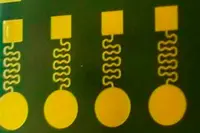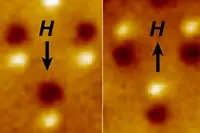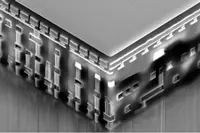Electronics News
Archive : 14 March 2016 год
 Scientists at the University of California, San Diego, have looked to the body's immune system for inspiration on how to fix ever more intricate electronic devices. The team, led by Professor Joseph Wang, have built self-propelled nanomotors that can seek out and repair tiny scratches to electronic systems. The researchers say the nanomotors could one day lead to flexible batteries, electrodes, solar cells and other gadgets that heal themselves.
Scientists at the University of California, San Diego, have looked to the body's immune system for inspiration on how to fix ever more intricate electronic devices. The team, led by Professor Joseph Wang, have built self-propelled nanomotors that can seek out and repair tiny scratches to electronic systems. The researchers say the nanomotors could one day lead to flexible batteries, electrodes, solar cells and other gadgets that heal themselves.
"Electronic circuits are very sophisticated these days," said Jinxing Li, a Ph.D. candidate in Prof Wang’s lab. "But a crack, even an extremely small one, can interrupt the flow of current and eventually lead to the failure of a device. Traditional electronics can be fixed with soldering, but repairing advanced electronics on a nanoscale requires innovation."
Gadgets will soon be more ubiquitous than ever, appearing in our clothes, implants and accessories. But finding ways to fix nanocircuits, battery electrodes or other electronic components when they break remains a challenge.
Replacing whole devices or even parts can be tricky or expensive, particularly if they're integrated in clothes or located in remote places. To work toward the goal of creating devices that heal themselves, Prof Wang’s team have turned to nature for ideas.
"If you cut your finger, for example, platelets will automatically localise at the wound location and help start the healing process," Li explained. "What we wanted to do is create and use extremely small robots to perform the same function, except in an electronic system."
To accomplish this, Wang's team designed and built nanoparticles out of gold and platinum that are powered by hydrogen peroxide. The platinum stimulates the fuel to break down into water and oxygen, which propels the particles. In testing, the researchers said that the nanomotors moved over the surface of a broken electronic circuit connected to an LED. When they approached the scratch, they got lodged in it, bridging the gap between the two sides and, because the particles are made of conductive metals, they allowed current to flow again, lighting up the LED.
Li says the nanomotors would be suitable for hard-to-repair electronic components such as the conductive layer of solar cells, which are subject to harsh environmental conditions and prone to scratching. They could also be used to heal flexible sensors and batteries, which Prof Wang’s lab is also developing.
Author
Tom Austin-Morgan
Source: www.newelectronics.co.uk
 Engineers at the University of California, Berkeley (UC Berkeley), claim to have shown for the first time that magnetic chips can operate with the lowest fundamental level of energy dissipation possible under the laws of thermodynamics. This means that dramatic reductions in power consumption are possible - as much as one-millionth the amount of energy per operation used by transistors in modern computers.
Engineers at the University of California, Berkeley (UC Berkeley), claim to have shown for the first time that magnetic chips can operate with the lowest fundamental level of energy dissipation possible under the laws of thermodynamics. This means that dramatic reductions in power consumption are possible - as much as one-millionth the amount of energy per operation used by transistors in modern computers.
"We wanted to know how small we could shrink the amount of energy needed for computing," said Jeffrey Bokor, professor of electrical engineering and computer sciences at UC Berkeley. "The biggest challenge in designing computers and, in fact, all our electronics today is reducing their energy consumption."
Lowering energy use is a relatively recent shift in focus in chip manufacturing after decades of emphasis on packing greater numbers of smaller and faster transistors onto chips.
"Making transistors go faster was requiring too much energy," Prof Bokor continued. "The chips were getting so hot they'd just melt."
The engineers say that magnetic computing has emerged as a promising alternative to conventional transistors because the magnetic bits can be differentiated by direction, and it takes just as much energy to get the magnet to point left as it does to point right.
The UC Berkeley team used an innovative technique to measure the tiny amount of energy dissipation that resulted when they flipped a nanomagnetic bit. They used a laser probe to follow the direction that the magnet was pointing as an external magnetic field was used to rotate the magnet from ‘up’ to ‘down’ or vice versa.
They determined that it took 15meV (millielectron volts) of energy to flip a magnetic bit at room temperature. This is said to be the first time that a practical memory bit has been manipulated and observed under conditions that would allow the Landauer limit to be reached, the researchers said.
While this is a proof of principle, Prof Bokor noted that putting such chips into practical production will take more time. But the researchers noted that "the significance of this result is that today's computers are far from the fundamental limit and that future dramatic reductions in power consumption are possible."
Pic: Magnetic microscope image of three nanomagnetic computer bits. Each is a tiny bar magnet 90nm long. The image shows a bright spot at the 'North' end & a dark spot at the 'South' end of the magnet. The 'H' arrow shows the direction of the magnetic field
Author
Tom Austin-Morgan
Source: www.newelectronics.co.uk
 Chinese foundry SMIC has signed a strategic partnership with resistive RAM developer Crossbar that will focus on the development and production of RRAM technology.
Chinese foundry SMIC has signed a strategic partnership with resistive RAM developer Crossbar that will focus on the development and production of RRAM technology.
Under the deal, the partners will provide customers with RRAM blocks based on SMIC’s 40nm CMOS process, a move that will enable the technology to be integrated into into MCUs and SoCs for a range of applications.
“Crossbar continues to execute on schedule and is now entering the licensing phase,” said George Minassian, Crossbar’s CEO and cofounder. “Designers of highly integrated MCUs and SoCs need non volatile memory technologies that are easy to integrate into their products and which can be manufactured using standard CMOS logic processes. Crossbar RRAM technology and SMIC manufacturing expertise are creating a new era of memory architectures with tighter security, lower power consumption while providing more capacity and fast access time.”
Crossbar RRAM cells are integrated in standard CMOS processes between two metal lines of standard CMOS wafers. This is said to result in highly integrated solutions, with non volatile memory, processing cores, analogue and RF on one die.
Dr Tzu-Yin Chiu, SMIC’s CEO, noted: “We’re delighted to have Crossbar as a new partner in our stable and reliable 40nm technology platform.”
Author
Graham Pitcher
Source: www.newelectronics.co.uk

